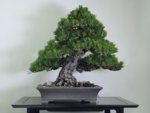I always thought of it as a balancing technique that is sometimes useful when part of the tree has short needles and part still has longer needles. The operative word here is "sometimes". But I had never really thought about it in depth.
Agreed, here is one situation that i have used it to help balancing and attaining shorter needles. The tree is a collected Shore Pine that i planted in a rock. ( Pinus Contorta ) There is a upside down cone shaped passage through the rock to the base, allowing the roots to populate the tray. I chipped and carved so the rock had feet for balancing and to allow the roots to spread out throughout the entire tray. The tree itself is under 6 inches in height.
Even though the natural needles are only 1 1/2 inch long , i desired shorter needles and also more buds in a very small space due to the scale of the planting.
The first time i used the needle cutting technique in combination with needle reduction the tree responded well with lots of new buds that came out with shorter needles. I then allowed the tree to recover for a season with just normal fall needle maintenance. This past year i reduced pairs of needles and cut length of needles. Here are two pictures, the first shows normal size of needle and number of buds before the first application. The second shows the ugly phase from the last application. Foliage is weaker, poorer color and condition but the buds appear healthy and are starting to swell.
However, i think it is clear to see the increase of branching and buds that occurred as a result of the first time. Currently the needles are cut to approx 1/2 inch in length which is 1/2 of the length at the beginning of last year. After this season i will resort to only needle reduction and cut back, having reached my goal of interior growth and more compact form.
I definitely agree that this is not wise to do on a regular basis , not likely required in most situations, and heaven forbid if it was done for show purposes

The Shore Pine species is not as vigorous as JBP so a little riskier, as well as prone to red band needle cast so i am not reccomending this for others to try

. But with a tree this old, this small. Clearly a tough little specimen. Single flush , very small candles!












